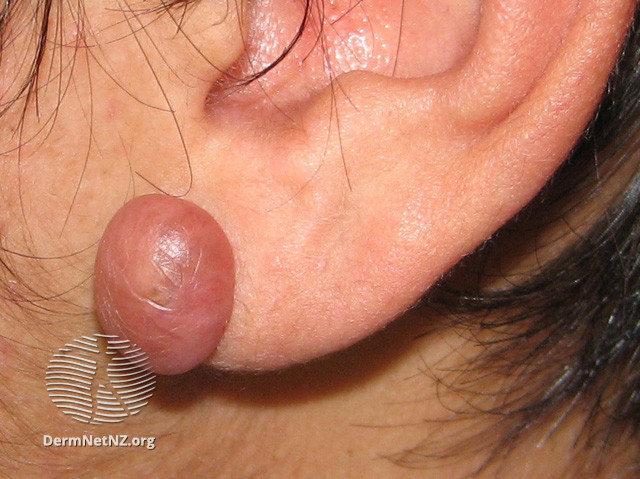
1/
A #dermtwitter #tweetorial on:
NXG (necrobiotic xanthogranuloma)
This #meded #foamed #medtwitter moment brought to you by episode 11 of @TheDermConsult!
What color do you expect to see when you hear NXG?
A #dermtwitter #tweetorial on:
NXG (necrobiotic xanthogranuloma)
This #meded #foamed #medtwitter moment brought to you by episode 11 of @TheDermConsult!
What color do you expect to see when you hear NXG?
2/
Yes, yellow! Whenever you hear something is “xanthomatous,” expect to see something yellow on exam! Kudos to all of you who guessed some form of a xanthomatous process on our prior mystery diagnosis tweet!👇
Yes, yellow! Whenever you hear something is “xanthomatous,” expect to see something yellow on exam! Kudos to all of you who guessed some form of a xanthomatous process on our prior mystery diagnosis tweet!👇
https://twitter.com/drsteventchen/status/1476268927722348544
3/
This diagnosis occurs classically by the eyes and correspondingly can cause ophthalmologic issues, so for those of you who suggested a referral to ophtho, absolutely agree!
This diagnosis occurs classically by the eyes and correspondingly can cause ophthalmologic issues, so for those of you who suggested a referral to ophtho, absolutely agree!
4/
But what other association is there? NXG is associated with gammopathies, so an SPEP is in order. However an SPEP alone doesn’t catch everything, so I always pair with a serum free light chain (+/- IFX) to improve the sensitivity and specificity.
ncbi.nlm.nih.gov/pmc/articles/P…
But what other association is there? NXG is associated with gammopathies, so an SPEP is in order. However an SPEP alone doesn’t catch everything, so I always pair with a serum free light chain (+/- IFX) to improve the sensitivity and specificity.
ncbi.nlm.nih.gov/pmc/articles/P…

5/
If you find an underlying disease process, treating it is the best bet to help the skin. However, sometimes it’s not convincing enough to be a significant finding for onc/heme to treat. That’s when we talk about how while some might call it MGUS, we do think it’s significant!
If you find an underlying disease process, treating it is the best bet to help the skin. However, sometimes it’s not convincing enough to be a significant finding for onc/heme to treat. That’s when we talk about how while some might call it MGUS, we do think it’s significant!
6/
Even if a gammopathy found is considered mild, if there’s a skin finding impacting sight, we’d certainly argue it’s an MGODS (monoclonal gammopathy of dermatologic significance😅). This is where a good partnership with onc/heme may help get the patient appropriate treatment!
Even if a gammopathy found is considered mild, if there’s a skin finding impacting sight, we’d certainly argue it’s an MGODS (monoclonal gammopathy of dermatologic significance😅). This is where a good partnership with onc/heme may help get the patient appropriate treatment!
7/
So what if nothing is found on screening tests, how do you treat? Sadly not a lot has been found to work. Prednisone, surgery, mechlorethamine & others have been reported, but IVIG seems to show the most promise.
Nice review from @AMostaghimi & team! jamanetwork.com/journals/jamad…
So what if nothing is found on screening tests, how do you treat? Sadly not a lot has been found to work. Prednisone, surgery, mechlorethamine & others have been reported, but IVIG seems to show the most promise.
Nice review from @AMostaghimi & team! jamanetwork.com/journals/jamad…
8/
Let’s talk exam. This finding of yellow indurated papules and plaques in the periocular areas is classic for NXG. In darker skin, the color may be less yellow and more brown.
Pc: jcasonline.com/article.asp?is…
Let’s talk exam. This finding of yellow indurated papules and plaques in the periocular areas is classic for NXG. In darker skin, the color may be less yellow and more brown.
Pc: jcasonline.com/article.asp?is…

9/
What about the differential? Xanthelasma is the other main yellow plaque in the periocular area. But the distinction is rather standard and the plaques are thinner and much less destructive. Given the associations, lipids and LFTs may be checked!
What about the differential? Xanthelasma is the other main yellow plaque in the periocular area. But the distinction is rather standard and the plaques are thinner and much less destructive. Given the associations, lipids and LFTs may be checked!

10/
SUMMARY:
- NXG is a rare disorder that occurs in the setting of gammopathies, with a yellow papular eruption around the eyes.
- the process can be destructive and can have ophthalmologic adverse events.
- treatment is difficult, but caring for underlying processes is key!
SUMMARY:
- NXG is a rare disorder that occurs in the setting of gammopathies, with a yellow papular eruption around the eyes.
- the process can be destructive and can have ophthalmologic adverse events.
- treatment is difficult, but caring for underlying processes is key!
11/11
Thanks for joining for this latest brief #tweetorial on NXG! Although rare, I hope everyone learns something, even if just how to best screen for gammopathies!
Take a listen if you want to hear us talk through this as a mystery case!
thedermconsult.org/episodes/episo…
Thanks for joining for this latest brief #tweetorial on NXG! Although rare, I hope everyone learns something, even if just how to best screen for gammopathies!
Take a listen if you want to hear us talk through this as a mystery case!
thedermconsult.org/episodes/episo…
• • •
Missing some Tweet in this thread? You can try to
force a refresh














